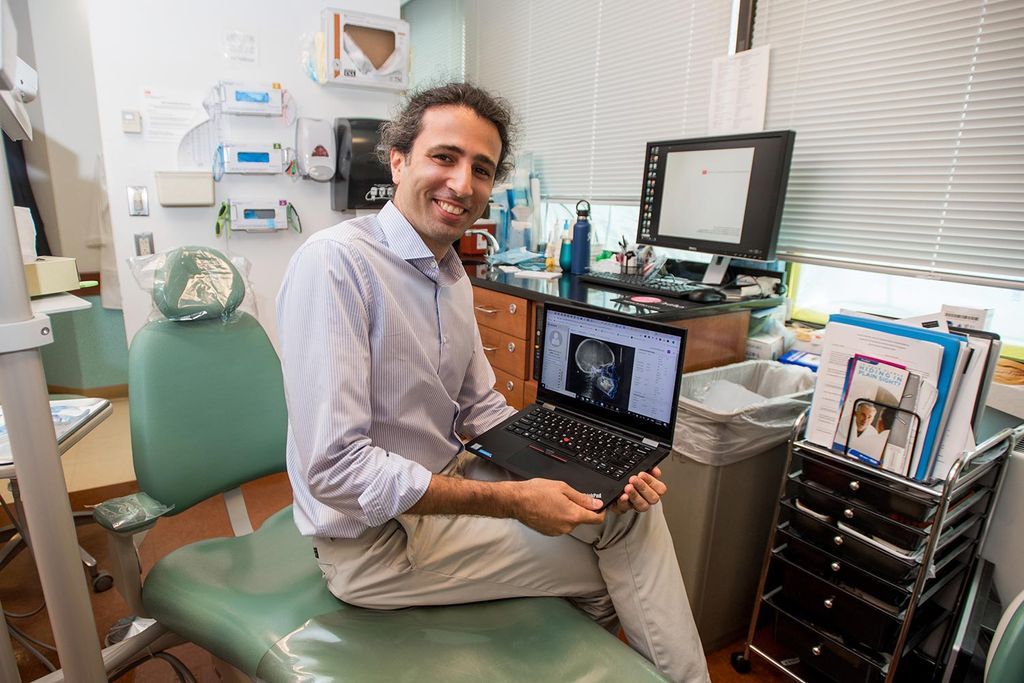Brace Yourselves, AI Is Coming to the Orthodontist’s Office
Brace Yourselves, AI Is Coming to the Orthodontist’s Office
BU researcher has developed an AI-based software that automates measurements for braces, more

As sometimes happens with the best ideas, this one—using artificial intelligence to improve orthodontics—started on a paper napkin.
“A typical story,” orthodontist Melih Motro says with a chuckle. Five years ago, Motro relocated to Boston from Istanbul, Turkey, to begin teaching orthodontics at Boston University’s Henry M. Goldman School of Dental Medicine (SDM). He’s been an innovator ever since, working to integrate new technologies like artificial intelligence and automation into his field of practice.
In 2017, Motro and a fellow orthodontist were walking through a park near BU, discussing the inefficiencies of manually calculating the facial dimensions that are necessary for planning braces and other kinds of orthodontic treatments. An idea occurred to Motro–those same measurements could be automated, he suggested, becoming excited at the thought of using AI to get the job done.
That’s when he pulled out the napkin and started scribbling away.
“If we can automate [face and head] measurements, that will speed up the process in diagnosis and treatment planning for orthodontists,” Motro explains.
Two years after jotting down his thoughts on a napkin, Motro and his team have developed an AI-based software called OrthoDx, which is capable of pinpointing and measuring facial structures by analyzing X-ray images of the side of a person’s head.
What started off as a research project quickly became focused on “creating something new that makes orthodontists’ lives easier,” says Motro.
Typically, for each patient, an orthodontist spends 10 to 15 minutes using X-ray images to map out key dimensions of the face and head. They do so by locating certain anatomical landmarks of facial structures, like the distance between the upper teeth and the lower jaw.
To speed up this process, Motro’s team developed software to learn from X-rays and recognize the facial structures in the image, automatically assigning those key landmark points on a patient’s face. Using the software, orthodontists still have full control of the measurements and landmarks and can customize measurements to a patient’s needs, but will no longer have to map them out by hand.

With the X-ray analysis finished in seconds by the AI software, and the time needed to manually calculate facial dimensions eliminated, the orthodontist can develop a patient’s treatment plan on the spot, giving them more face-to-face time with each of their patients.
For the researchers, this was step one. Now, Motro, who is an SDM clinical associate professor of orthodontics and dentofacial orthopedics and the research director of the orthodontics and dentofacial orthopedics department, is moving the AI-based software from the lab into the clinic through the formation of a start-up company called Phimentum, which launched in April 2019.
Motro and the team behind Phimentum—which combines the Greek word for gold standard, ”phi,” with the Latin word for chin, “mentum”—plan to bring OrthoDx to market and develop additional automated tools for all orthodontic diagnostic processes within the next 5 to 10 years. The researchers are currently working on six other projects, including a similar system that can calculate measurements from frontal X-ray scans of a person’s face and jaw.

Comments & Discussion
Boston University moderates comments to facilitate an informed, substantive, civil conversation. Abusive, profane, self-promotional, misleading, incoherent or off-topic comments will be rejected. Moderators are staffed during regular business hours (EST) and can only accept comments written in English. Statistics or facts must include a citation or a link to the citation.